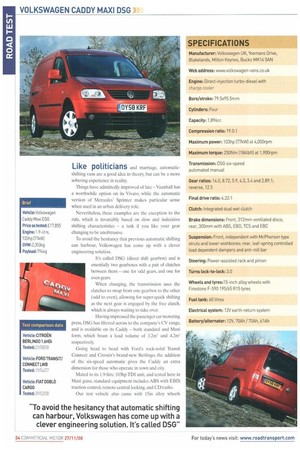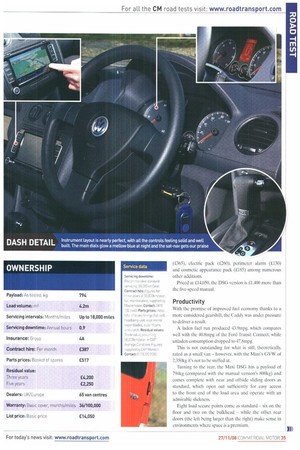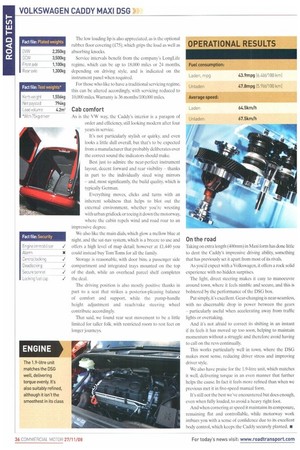Volkswagen
Page 33

Page 34

Page 35

Page 36

If you've noticed an error in this article please click here to report it so we can fix it.
Caddy Maxi 130
By fitting its impressive DSG automatic gearbox, Volkswagen has broadened the appeal of the Caddy Maxi.
Words: Julian Manes / Images: Tom Cunningham Like politicians and marriage, automaticshifting vans are a good idea in theory, but can be a more sobering experience in reality.
Things have admittedly improved of late — Vauxhall has a worthwhile option on its Vivaro, while the automatic version of Mercedes' Sprinter makes particular sense when used in an urban delivery role.
Nevertheless, these examples are the exception to the rule, which is invariably based on slow and indecisive shifting characteristics — a task if you like your gear changing to be unobtrusive, To avoid the hesitancy that previous automatic shifting can harbour, Volkswagen has come up with a clever engineering solution.
It's called DSG (direct shift gearbox) and is essentially two gearboxes with a pair of clutches between them — one for odd gears, and one for even gears.
When changing, the transmission uses the clutches to swap from one gearbox to the other (odd to even), allowing for super-quick shifting as the next gear is engaged by the free clutch. which is always waiting to take over.
Having impressed the passenger car motoring press. DSG has filtered across to the company's CV range, and is available on its Caddy — both standard and Maxi form, which boast a load volume of 3.2m and 4.2m3 respectively.
Going head to head with Ford's rock-solid Transit Connect and Citroen's brand-new Berlingo, the addition of the six-speed automatic gives the Caddy an extra dimension for those who operate in town and city.
Mated to its 1,9-litre 103hp TD1 unit, and tested here in Maxi guise, standard equipment includes ABS with EBD, traction control, remote central locking, and CD/radio.
Our test vehicle also came with 15in alloy wheels
(1.365.), electric pack (£260), perimeter alarm (£130) and cosmetic appearance pack (£.185) among numerous other additions.
Priced at 114,050, the DSG version is £1,400 more than the five-speed manual.
Productivity
With the promise of improved fuel economy thanks to a more considered gearshift, the Caddy was under pressure to deliver a result.
A laden fuel run produced 43.9mpg, which compares well with the 40.8mpg of the Ford Transit Connect, while unladen consumption dropped to 47.8mpg.
This is not outstanding for what is still, theoretically, rated as a small van — however, with the Maxi's GVW of 1350kg it's not to be sniffed at.
Turning to the rear, the Maxi DSG has a payload of 794kg (compared with the manual version's 800kg) and comes complete with near and offside sliding doors as standard, which open out sufficiently for easy access to the front end of the load area and operate with an admirable slickness.
Eight load secure points come as standard — six on the floor and two on the bulkhead — while the offset rear doors (the left being larger than the right) make sense in environments where space is a premium. The low loading lip is also appreciated, as is the optional rubber floor covering (175), which grips the load as well as absorbing knocks.
Service intervals benefit from the company's LongLife regime, which can be up to 18,000 miles or 24 months, depending on driving style, and is indicated on the instrument panel when required.
For those who like to have a traditional servicing regime, this can be altered accordingly, with servicing reduced to 10,000 miles Warranty is 36 months/100,000 miles
Cab comfort
As is the VW way, the Caddy's interior is a paragon of order and efficiency, still looking modern after four years in service.
It's not particularly stylish or quirky, and even looks a little dull overall, but that's to be expected from a manufacturer that probably deliberates over the correct sound the indicators should make.
Best just to admire the near-perfect instrument layout, decent forward and rear visibility — thanks in part to the individually sized wing mirrors — and, most significantly, the build quality, which is typically German.
Everything moves, clicks and turns with an inherent solidness that helps to blot out the external environment, whether you're wresting with urban gridlock or toeing it down the motorway, where the cabin repels wind and road roar to an impressive degree.
We also like the main dials, which glow a mellow blue at night, and the sat-nay system, which is a breeze to use and offers a high level of map detail; however at £1.440 you could instead buy Tom Toms for all the family.
Storage is reasonable, with door bins, a passenger side compartment and integrated trays mounted on the top of the dash, while an overhead parcel shelf completes the deal.
The driving position is also mostly positive thanks in part to a seat that strikes a posterior-pleasing balance of comfort and support, while the pump-handle height adjustment and reach/rake steering wheel contribute accordingly.
That said, we found rear seat movement to be a little limited for taller folk, with restricted room to rest feet on longer journeys.
On the road
Taking on extra length (40Ornm) in Main form has done little to dent the Caddy's impressive driving ability, something that has previously set it apart from most of its rivals As you'd expect with a Volkswagen, it offers a rock solid experience with no hidden surprises.
The light, direct steering makes it easy to manoeuvre around town, where it feels nimble and secure, and this is bolstered by the performance of the DSG box.
Put simply, it's excellent. Gear-changing is near-seamless, with no discernable drop in power between the gears — particularly useful when accelerating away from traffic lights or overtaking.
And it's not afraid to correct its shifting in an instant if its feels it has moved up too soon, helping to maintain momentum without a struggle and therefore avoid having to call on the revs continually.
This works particularly well in town, where the DSG makes most sense, reducing driver stress and improving driver style.
We also have praise for the 1.9-litre unit, which matches it well, delivering torque in an even manner that further helps the cause. In fact it feels more refined than when we previous met it in five-speed manual form.
It's still not the best we've encountered but does enough, even when fully loaded, to avoid a heavy right foot.
And when cornering at speed it maintains its composure, remaining flat and controllable, while motorway work imbues you with a sense of confidence due to its excellent body control, which keeps the Caddy securely planted. •




















































































































































